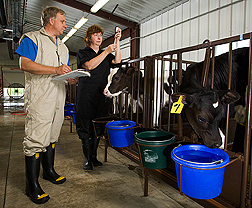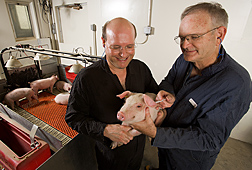Getting Around Maternal Defenses
New ways to bypass antibodies that
hinder vaccination of young livestock
ARS scientists in Ames, Iowa, are studying two approaches—one using a virus linked to the common cold and the other using T-cells—to get past maternal defenses that thwart vaccination of very young livestock.
The hurdles researchers at the National Animal Disease Center (NADC) are trying to clear are antibodies mothers pass to newborns that protect the young from bacteria and viruses.
“Animals like cattle and swine are born without antibodies,” says NADC veterinary medical officer Ronald Wesley. “They get their immunity from suckling their mother’s colostrum during the first 24 to 36 hours after birth.”
The problem is that the protective maternal antibodies also render vaccines ineffective until the antibodies decay within the newborns’ systems.
“These studies are using two novel ways to get vaccines to bypass maternal-antibody protection: delivering the vaccines by way of a viral vector and stimulating the cellular branch of the immune system,” says Cyril Gay, national program leader for ARS’s Animal Health research programs.
|
|
Cold Viruses Deliver Vaccines
Some adenoviruses can cause respiratory illnesses in humans, such as the common cold, pneumonia, and bronchitis. They can also spur other maladies such as gastroenteritis, conjunctivitis, cystitis, and rashes.
Their ability to infect cells makes adenoviruses good delivery vehicles, or “vectors,” for genetic material. In his research, Wesley used an attenuated (weakened) human adenovirus as a vector of two swine flu genes. The result is a new, recombinant virus that effectively immunized recently born piglets that had suckled maternal influenza-fighting antibodies.
Wesley, who was assisted by NADC veterinary medical officer Kelly Lager, says the potentially major breakthrough may close a window of vulnerability during which the maternal antibodies’ waning powers still repel vaccines but leave animals vulnerable to diseases.
“Since the adenovirus is of human origin, livestock have no maternal antibody resistance to it,” he explains. “The recombinant virus infects cells in the piglet and then expresses two swine flu proteins—one that gives specific immunity against a flu virus known as ‘H3N2’ and another that gives broader immunity to the disease.”
Wesley adds that the recombinant virus is self-limiting. “That means it won’t spread to other cells,” he says. “Moreover, it won’t spread to littermates of vaccinated piglets.
“This work is novel and significant. Overcoming maternal antibody interference is a particularly important development in work against swine flu and towards a vaccine.”
While swine influenza causes epidemics of acute respiratory disease in pigs, strains have occasionally become directly transmissible—and dangerous—to humans. Young pigs are more severely affected than older ones.
T-Cells Tackle Viruses Too
Meanwhile, testing led by NADC virologists Julia Ridpath and John Neill indicates that exposing suckling calves to bovine viral diarrhea virus (BVDV) generates a T-cell response that will fight off the virus. T-cells are lymphocytes that play key roles in initiation or suppression of immunity.
There’s no treatment for BVDV, which costs U.S. cattle producers millions of dollars in losses each year and induces diseases affecting animal reproduction and nutrition, milk output, and digestive and respiratory function. In pregnant cows, infection can cause spontaneous abortion or premature birth, and calves born with it can infect herds throughout their entire lives.
“Our results suggest that exposing young calves to live BVDV while maternal antibodies are present generates T-cell-mediated immunity to BVDV,” says Ridpath.
Ridpath, Neill, and bovine immunologists Janice Endsley of the University of Missouri-Columbia and James Roth at Iowa State University conducted two trials to spur and evaluate this immune response. In their first trial, calves still possessing high levels of circulating maternal antibodies were exposed to a virulent BVDV 2-type strain at between 2 and 5 weeks of age and again after maternal antibodies had waned.
“Calves were protected from clinical disease after both exposures,” says Ridpath, “first by the maternal antibodies and then by an immune response they generated themselves in response to the first viral exposure. Since the maternal antibodies did not block a BVDV-specific T-cell immune response, vaccination of suckling animals can be effective.”
In a second experiment, 7-week-old calves with circulating maternal antibody to BVDV were given one of two vaccines: a modified live vaccine containing the strains BVDV 1 and BVDV 2 or a killed vaccine containing BVDV 1 and BVDV 2.
A control group of calves received no vaccine at all. Serum-neutralizing antibody levels and antigen-specific T-cell responses were monitored for 14 weeks after vaccination.
“Calves vaccinated with the modified live vaccine developed T-cell-mediated immune responses. But the killed-BVDV vaccines did not generate measurable T-cell immune responses,” says Ridpath.
“We’re not recommending that ranchers go out and expose young animals to live viruses,” says Gay. “It would be too risky to assume that the mother animals carry specific maternal antibodies in amounts high enough to protect their young.
“But the results indicate that the cellular branch of the immune system is responsible for the protective immunity seen after a challenge with a fully virulent virus. That’s important because many of the more problematic viral pathogens we face today may require both cellular and antibody responses for protective immunity.”—By Luis Pons, Agricultural Research Service Information Staff.
This research is part of Animal Health, an ARS National Program (#103) described on the World Wide Web at www.nps.ars.usda.gov.
Ronald Douglas Wesley and Julia F. Ridpath are in the USDA-ARS Virus and Prion Diseases of Livestock Research Unit, National Animal Disease Center, 2300 Dayton Rd., Ames, IA 50010-0070; phone (515) 663-7358 [Wesley], (515) 663-7586 [Ridpath], fax (515) 663-7458.
"Getting Around Maternal Defenses" was published in the November/December 2006 issue of Agricultural Research magazine.








